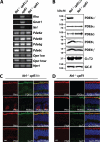Rod phosphodiesterase-6 (PDE6) catalytic subunits restore cone function in a mouse model lacking cone PDE6 catalytic subunit
- PMID: 21799013
- PMCID: PMC3190866
- DOI: 10.1074/jbc.M111.259101
Rod phosphodiesterase-6 (PDE6) catalytic subunits restore cone function in a mouse model lacking cone PDE6 catalytic subunit
Abstract
Rod and cone photoreceptor neurons utilize discrete PDE6 enzymes that are crucial for phototransduction. Rod PDE6 is composed of heterodimeric catalytic subunits (αβ), while the catalytic core of cone PDE6 (α') is a homodimer. It is not known if variations between PDE6 subunits preclude rod PDE6 catalytic subunits from coupling to the cone phototransduction pathway. To study this issue, we generated a cone-dominated mouse model lacking cone PDE6 (Nrl(-/-) cpfl1). In this animal model, using several independent experimental approaches, we demonstrated the expression of rod PDE6 (αβ) and the absence of cone PDE6 (α') catalytic subunits. The rod PDE6 enzyme expressed in cone cells is active and contributes to the hydrolysis of cGMP in response to light. In addition, rod PDE6 expressed in cone cells couples to the light signaling pathway to produce S-cone responses. However, S-cone responses and light-dependent cGMP hydrolysis were eliminated when the β-subunit of rod PDE6 was removed (Nrl(-/-) cpfl1 rd). We conclude that either rod or cone PDE6 can effectively couple to the cone phototransduction pathway to mediate visual signaling. Interestingly, we also found that functional PDE6 is required for trafficking of M-opsin to cone outer segments.
Figures







Similar articles
-
Exchange of Cone for Rod Phosphodiesterase 6 Catalytic Subunits in Rod Photoreceptors Mimics in Part Features of Light Adaptation.J Neurosci. 2015 Jun 17;35(24):9225-35. doi: 10.1523/JNEUROSCI.3563-14.2015. J Neurosci. 2015. PMID: 26085644 Free PMC article.
-
Targeted ablation of the Pde6h gene in mice reveals cross-species differences in cone and rod phototransduction protein isoform inventory.J Biol Chem. 2015 Apr 17;290(16):10242-55. doi: 10.1074/jbc.M114.611921. Epub 2015 Mar 4. J Biol Chem. 2015. PMID: 25739440 Free PMC article.
-
Photoreceptor phosphodiesterase (PDE6): activation and inactivation mechanisms during visual transduction in rods and cones.Pflugers Arch. 2021 Sep;473(9):1377-1391. doi: 10.1007/s00424-021-02562-x. Epub 2021 Apr 15. Pflugers Arch. 2021. PMID: 33860373 Free PMC article. Review.
-
The N termini of the inhibitory γ-subunits of phosphodiesterase-6 (PDE6) from rod and cone photoreceptors differentially regulate transducin-mediated PDE6 activation.J Biol Chem. 2019 May 24;294(21):8351-8360. doi: 10.1074/jbc.RA119.007520. Epub 2019 Apr 8. J Biol Chem. 2019. PMID: 30962282 Free PMC article.
-
New focus on regulation of the rod photoreceptor phosphodiesterase.Curr Opin Struct Biol. 2021 Aug;69:99-107. doi: 10.1016/j.sbi.2021.03.016. Epub 2021 May 1. Curr Opin Struct Biol. 2021. PMID: 33945959 Free PMC article. Review.
Cited by
-
Deficiency of Isoprenylcysteine Carboxyl Methyltransferase (ICMT) Leads to Progressive Loss of Photoreceptor Function.J Neurosci. 2016 May 4;36(18):5107-14. doi: 10.1523/JNEUROSCI.0176-16.2016. J Neurosci. 2016. PMID: 27147662 Free PMC article.
-
LINC complexes mediate the positioning of cone photoreceptor nuclei in mouse retina.PLoS One. 2012;7(10):e47180. doi: 10.1371/journal.pone.0047180. Epub 2012 Oct 5. PLoS One. 2012. PMID: 23071752 Free PMC article.
-
AIPL1, A protein linked to blindness, is essential for the stability of enzymes mediating cGMP metabolism in cone photoreceptor cells.Hum Mol Genet. 2014 Feb 15;23(4):1002-12. doi: 10.1093/hmg/ddt496. Epub 2013 Oct 9. Hum Mol Genet. 2014. PMID: 24108108 Free PMC article.
-
CNGA3 is expressed in inner ear hair cells and binds to an intracellular C-terminus domain of EMILIN1.Biochem J. 2012 Apr 15;443(2):463-76. doi: 10.1042/BJ20111255. Biochem J. 2012. PMID: 22248097 Free PMC article.
-
Atypical retinal degeneration 3 in mice is caused by defective PDE6B pre-mRNA splicing.Vision Res. 2012 Mar 15;57:1-8. doi: 10.1016/j.visres.2012.01.017. Epub 2012 Feb 4. Vision Res. 2012. PMID: 22326271 Free PMC article.
References
Publication types
MeSH terms
Substances
Grants and funding
LinkOut - more resources
Full Text Sources
Molecular Biology Databases
Miscellaneous

